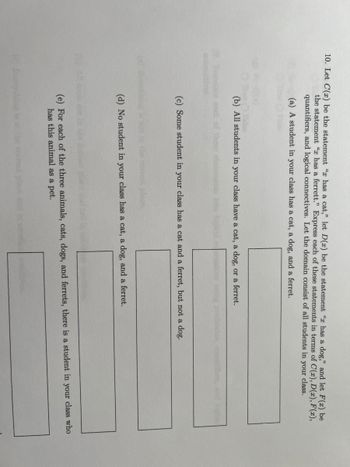
Advanced Engineering Mathematics
10th Edition
ISBN: 9780470458365
Author: Erwin Kreyszig
Publisher: Wiley, John & Sons, Incorporated
expand_more
expand_more
format_list_bulleted
Question

Transcribed Image Text:10. Let C(x) be the statement " has a cat," let D(x) be the statement " has a dog," and let F(x) be
the statement " has a ferrett." Express each of these statements in terms of C(x), D(x), F(x),
quantifiers, and logical connectives. Let the domain consist of all students in your class.
(a) A student in your class has a cat, a dog, and a ferret.
(b) All students in your class have a cat, a dog, or a ferret.
(c) Some student in your class has a cat and a ferret, but not a dog.
(d) No student in your class has a cat, a dog, and a ferret.
(e) For each of the three animals, cats, dogs, and ferrets, there is a student in your class who
has this animal as a pet.
Expert Solution
arrow_forward
Step 1
Note: As per the honor code, only one question can be solved at a time and up to 3 sub-parts only. Please post other sub-parts separately.
Given-
: "x has a cat"
: "x has a dog"
: "x has a ferrett"
To find-
- A student in your class has a cat, a dog, and a ferret.
- All students in your class have a cat, a dog, or a ferret.
- Some student in your class has a cat, and a ferret, but not a dog.
Step by stepSolved in 2 steps

Knowledge Booster
Similar questions
- An invalid argument is given below. 3X (P(x) v Q(x)) Vx P(x) (X)O XE : Suppose that the domain of x is the set {a, b}. Fill in the table values that prove that the argument is invalid. a Pick v Pick v Pick v 4 Check Nextarrow_forwardLet P(x, y) be "x has taken class y," and Q(x, y) be "x has passed class y" and M(y) be "y is a math class," where the domain of x consists of all students in your class and the domain of y consists of all classes at LU. Use quantifiers to express this statement. (Assume that all email messages that were sent are received.) Every student in your class has passed a class at Liberty University that is not a math class.arrow_forwardCheck if the following statement is TRUE or FALSE. Let p(x) and g(x) be two open predicates in a universe of discourse. Is it true that (x) (p(x) v g(x)) is equivalent to (Vxp(x)) v (Vxq(x))? O True O Falsearrow_forward
- Show by example that these three statements are generally false:(a) A and AT have the same nullspace.(b) A and AT have the same free variables.(c) If R is the reduced form rref(A) then RT is rref(AT ).arrow_forward#26arrow_forward8. Give an example of a predicate P(x) and different domains so that the state- ments VxP(x) is true, VxP(x) is false, xP(x) is true, xP(x) is false.arrow_forward
arrow_back_ios
arrow_forward_ios
Recommended textbooks for you
 Advanced Engineering MathematicsAdvanced MathISBN:9780470458365Author:Erwin KreyszigPublisher:Wiley, John & Sons, Incorporated
Advanced Engineering MathematicsAdvanced MathISBN:9780470458365Author:Erwin KreyszigPublisher:Wiley, John & Sons, Incorporated Numerical Methods for EngineersAdvanced MathISBN:9780073397924Author:Steven C. Chapra Dr., Raymond P. CanalePublisher:McGraw-Hill Education
Numerical Methods for EngineersAdvanced MathISBN:9780073397924Author:Steven C. Chapra Dr., Raymond P. CanalePublisher:McGraw-Hill Education Introductory Mathematics for Engineering Applicat...Advanced MathISBN:9781118141809Author:Nathan KlingbeilPublisher:WILEY
Introductory Mathematics for Engineering Applicat...Advanced MathISBN:9781118141809Author:Nathan KlingbeilPublisher:WILEY Mathematics For Machine TechnologyAdvanced MathISBN:9781337798310Author:Peterson, John.Publisher:Cengage Learning,
Mathematics For Machine TechnologyAdvanced MathISBN:9781337798310Author:Peterson, John.Publisher:Cengage Learning,


Advanced Engineering Mathematics
Advanced Math
ISBN:9780470458365
Author:Erwin Kreyszig
Publisher:Wiley, John & Sons, Incorporated

Numerical Methods for Engineers
Advanced Math
ISBN:9780073397924
Author:Steven C. Chapra Dr., Raymond P. Canale
Publisher:McGraw-Hill Education

Introductory Mathematics for Engineering Applicat...
Advanced Math
ISBN:9781118141809
Author:Nathan Klingbeil
Publisher:WILEY

Mathematics For Machine Technology
Advanced Math
ISBN:9781337798310
Author:Peterson, John.
Publisher:Cengage Learning,

